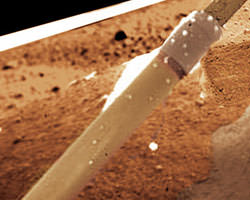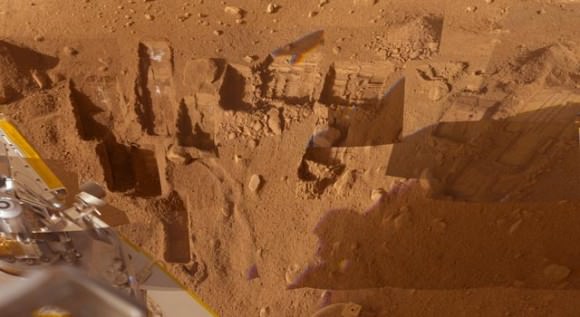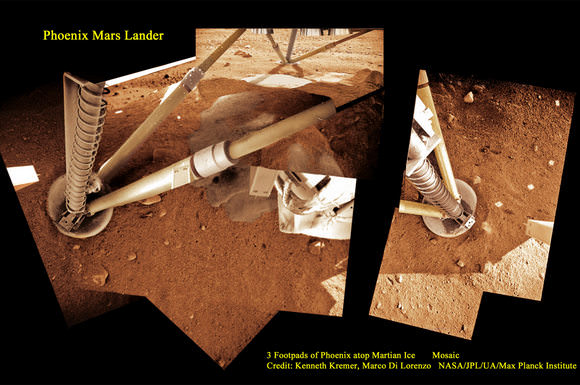[/caption]
Scientists say that the Arctic region studied by Phoenix lander may be a favorable environment for microbes. Just-right chemistry and periods where thin films of liquid water form on the surface could make for a habitable setting. “Not only did we find water ice, as expected, but the soil chemistry and minerals we observed lead us to believe this site had a wetter and warmer climate in the recent past — the last few million years — and could again in the future,” said Phoenix Principal Investigator Peter Smith of the University of Arizona, Tucson.
The Phoenix science team released four papers today after spending months interpreting the data returned by the lander during its 5-month mission.
The most surprising finding was perchlorate in the Martian soil. This Phoenix finding caps a growing emphasis on the planet’s chemistry, said Michael Hecht of from the Jet Propulsion Laboratory, who led a paper about Phoenix’s soluble-chemistry findings.
“The study of Mars is in transition from a follow-the-water stage to a follow-the-chemistry stage,” Hecht said. “With perchlorate, for example, we see links to atmospheric humidity, soil moisture, a possible energy source for microbes, even a possible resource for humans.”
Perchlorate, which strongly attracts water, makes up a few tenths of a percent of the composition in all three soil samples analyzed by Phoenix’s wet chemistry laboratory. It could pull humidity from the Martian air. At higher concentrations, it might combine with water as a brine that stays liquid at Martian surface temperatures. Some microbes on Earth use perchlorate as food. Human explorers might find it useful as rocket fuel or for generating oxygen.

A paper about Phoenix water studies, led by Smith, cites clues supporting an interpretation that the soil has had films of liquid water in the recent past. The evidence for water and potential nutrients “implies that this region could have previously met the criteria for habitability” during portions of continuing climate cycles, these authors conclude.
Phoenix dug down with its scoop and found ice just under the surface of Mars. “We wanted to know the origin of the ice,” Smith said. “It could have been the remnant of a larger polar ice cap that shrank; could have been a frozen ocean; could have been a snowfall frozen into the ground. The most likely theory is that water vapor from the atmosphere slowly diffused into the surface and froze at the level where the temperature matches the frost point. We expected that was probably the source of the ice, but some of what we found was surprising.”
Evidence that the ice in the area sometimes thaws enough to moisten the soil comes from finding calcium carbonate in soil heated in the lander’s analytic ovens or mixed with acid in the wet chemistry laboratory. Another paper from a team led by University of Arizona’s William Boynton report that the amount of calcium carbonate “is most consistent with formation in the past by the interaction of atmospheric carbon dioxide with liquid films of water on particle surfaces.”

The new reports leave unsettled whether soil samples scooped up by Phoenix contained any carbon-based organic compounds. The perchlorate could have broken down simple organic compounds during heating of soil samples in the ovens, preventing clear detection.
The heating in ovens did not drive off any water vapor at temperatures lower than 295 degrees Celsius (563 degrees Fahrenheit), indicating the soil held no water adhering to soil particles. Climate cycles resulting from changes in the tilt and orbit of Mars on scales of hundreds of thousands of years or more could explain why effects of moist soil are present.
Phoenix launched in August 2007and landed in May, 2008. Phoenix ended communications in November 2008 as the approach of Martian winter depleted energy from the lander’s solar panels.
Sources: JPL, EurekAlert, Spaceflightnow.com


Great article! Although….
“The heating in ovens did not drive off any water vapor at temperatures lower than 295 degrees Celsius (563 degrees Fahrenheit), indicating the soil held no water adhering to soil particles.”
….this information does not mention the ‘clumping’ of materials seen at the oven intake grates and how eventually that material seemed to ‘dry out’ and finally reach the oven(s). Could that have been an atmospheric condensate of water mixed in the sample?
Which consequentially evaporated…~
Without having seen the DATA, I do not accept any of the interpetations of what has been written.
The frost bubbles on the legs, can only mean one thing, that there is moisture on mars at least where the lander is!That moisture could be H2 and maybe O. Any one that lives in the Norhderen regions of this planet of ours knows that at an temperature of ~ -5 to -10C
these same frost bubbles are present on your car or on any metal for that matter!
Ergo the papers are speculative to say the least. And they say the oven temps was 295C? Where they frying an egg or where the
melting gold? I’m applaud their endavour,
but concrete result is another one?
Wish they think these objectives thru, before
putting an expensive piece of garbage on an
planet that is not ours.
I beg to difer… because as far as we know everything in the solar system belongs to us?! So the statement “…on a planet that is not ours.”, nay be presumptuous at best….
Goint a little further.. it IS possible, although unlikely, that the entire universe belongs to US….. That’d be nice.
For decades we were told the follow-the-water strategy was the trail to looking for life on Mars…..now we are in for decades of follow-the-chemistry? Pathetic. Why don’t we look for microbial life? Discovery of life on Mars will be the greatest discovery in the history of science – but the only direct search are the two Viking probes in the 1970’s….and their results were ambiguous. Organics on Mars are are still an unknown? How about following up on the spectroscopic “Sinton bands” suggestions of organics? And the other interesting signs that Mars is not a dead planet.
If I’m not mistaken, there is a book out there (which, due to censorship policies on this site, cannot be mentioned) with a small but steadily growing following that takes a serious look at these issues. I wish UniverseToday.com would review this book.
TD Says:
July 5th, 2009 at 7:03 am
“For decades we were told the follow-the-water strategy was the trail to looking for life on Mars…..now we are in for decades of follow-the-chemistry? Pathetic.”
Well, considering the only life we’re aware of uses chemistry to exist, particularly the action of water, then I don’t really think you can fault the logic used to this point. If you’re not basing your search off water or chemical markers, then what are you left with? Sending a probe to mars with the sole objective of looking for life based on entirely ambiguous spectroscopic data (chemical markers in themselves) with extremely poor spatial resolution that may or may not suggest organics somewhere on the planet would likely end up being the most expensive flop of all time.
And what if it plonks down and finds nothing – a null result? That wouldn’t appease anybody – people would simply say it’s in the wrong place. So then you have to build a mission that could travel and somehow thoroughly sample the Martian soil over a large area and in a diverse range of places. This would take many years on the martian surface, even assuming that we had the technology to keep some sort of rover or other robot alive on the surface for that long. That means big $$$.
NASA and the ESA will only send a dedicated ‘life-hunter’ when they are sure they have nailed down a location that seems extremely likely to have once harboured life. And that’s the way it should be.
Bravehart Says:
July 3rd, 2009 at 9:07 pm
“Wish they think these objectives thru, before
putting an expensive piece of garbage on an
planet that is not ours.”
I wish you’d think your comments through before posting a rambling piece of garbage like this, but hey – we can’t all have what we want, eh?
P.S. TD – censorship my ass. You’re the one censoring yourself so you can play victim. The moderation rules were put in place to stop every single post degenerating into an anti-science free for all. They are not there to stop considered conversation on controversial yet topical subjects that haven’t been thrashed to death hundreds of times in previous posts – i.e. EU and whatnot. This is a forum for topical issues in astronomy, not a place for proving ATM theories.
As far as I’m aware, not one single instance of the rules having to be enforced has even played out yet. I don’t even remember there being a warning. Stop crying about censorship – it’s called moderation and it needed to be done. Tell us the name of your book, what it’s claims are and stop whinging.
TD: Given enough money it should be be possible to plant a probe on Mars that goes about gather samples to run PCR (polymerase chain reaction) to determine if there are genomes from organisms in the soil. Another expensive probe might run soil samples through microscopic analysis. These could be combined with rovers or robots which ferry material to the lander-lab bench or act as their own lab bench.
It all costs money $$$, and that is where the real trick lies. If we put a few probes down on Mars with each Hohman transfer orbital window (about once a year) we might be able to detect for the presence or absence of martian life directly.
Of course it is entirely possible that the landing rockets vaporized some of the ice now exposed below the lander and THAT vapor caused a temporary ‘stickyness’ as seen at the oven grates?
Astrofiend – sorry, unless you represent the management of this site, I don’t think you have the authority to alter the censorship rules. As for the nameless book I alluded to, the author of this article has a copy.
The greatest scientific question 50 years ago was “does Mars have life?”. It’s 2009 and it’s at least conceivable that someone is dragging their feet. Of course the big question is “why”? The book is a somewhat speculative attempt to put together the pieces. If UniverseToday chooses not to review it, I suppose they have their reasons.